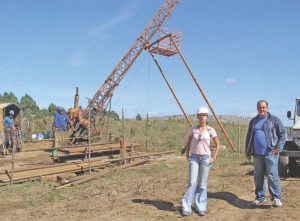VANCOUVER — Amarillo Gold (AGC-V, AGCBF-O) shot up 57% in one day’s trading after results from four stepout holes at its Lavras do Sul project in southern Brazil showed good gold mineralization over significant lengths.
The latest results are from the Butia target, one of four zones at Lavras. Hole 122 first cut a short, low-grade intercept — 29 metres of 0.4 gram gold per tonne from 5 metres depth — then cored 232 metres averaging 1.95 grams gold from 47 metres depth. The long intercept included 206 metres grading 2.16 grams gold.
Two other holes returned similar results. Hole 123 hit a 19-metre intercept grading 1.03 grams gold from 43 metres depth, followed by 227 metres of 1.84 grams gold from 80 metres. And hole 124 cut 40 metres of 1.75 grams gold from 37 metres depth, followed by 0.76 gram gold over 115 metres from 111 metres.
A fourth hole returned a shorter intercept: 1.36 grams gold over 54 metres from 37 metres depth. All four holes were drilled along the same section and collared 50 metres apart.
Butia was targeted because of a partly outcropping syenite zone. Amarillo geologists thought syenite was a favourable host for higher-grade gold mineralization in the area, a theory the latest results support. The intercepts appear to be hosted by an altered nepheline-syenite late-stage intrusive to the surrounding perthitic granite. Although the granite is mineralized, the company believes the silica-undersaturated nature of the syenite acted as a better trap for the mineralizing fluids.
Results from the four holes at Butia boosted Amarillo 57 to close at $1.57. The company has a 52-week trading range of 50-$1.84 and has 40.6 million shares issued.
Current drilling at Butia is along the next section to the west and the holes appear to have hit the same mineralized host. The syenite is open to the east, west, and at depth. In addition, Amarillo has mapped other syenite outcrops on the property, which it now plans to examine more closely.
The Lavras granite complex hosts numerous historic diggings and small mine workings — the area was named “diggings of the south” in Portuguese because of successive gold rushes in the 1880s and 1930s.
ABrazilian state-owned company drill-tested Lavras do Sul’s two main targets, Butia and Cerrito, in 1985. Rio Tinto(RTP-N, RIO-L) drill-tested the area in 2004 and though the major did not find the large oxide gold blanket it was seeking, it did solidify a large land position, consolidating numerous fractious land claims. In April 2006, Rio offered the project for sale; by September, Amarillo was signing an option agreement.
In late 2006, a drill program started with three holes into Butia. The first hole returned 157 metres from surface grading 1.05 grams gold, which included 12.5 metres of oxide mineralization grading 1.92 grams gold followed by 7.5 metres grading 1.41 grams gold in the transition zone. Amarillo recently moved a drill back to Butia with the goal of completing enough drilling to finish a resource estimate.
Moving away from Butia in early 2007, Amarillo focused on another target, Cerrito, where drilling to date has revealed three gold zones. The central zone strikes for 400 metres and is up to 50 metres wide; the other zones require more definition drilling. Promising results from Cerrito include 124 metres grading 0.9 gram gold from 2 metres depth in hole 4, 0.67 gram gold over 54 metres from surface in hole 5, 1.02 grams gold over 26 metres from surface in hole 17, and 55 metres grading 0.7 gram gold from 19 metres in hole 18.
And late last year, the company discovered a new gold zone at Lavras: a broad, low-grade zone spanning almost 400 metres of strike length called Caneleira. Five drill holes into the target produced such intercepts as: 36 metres grading 1.42 grams gold from 70 metres depth in hole 110; 37 metres grading 1.17 grams gold from surface in hole 111; and 266 metres from 8 metres depth grading 0.35 gram gold in hole 114.
A sealed road leads directly into the project and farm tracks crisscross the area. The nearby town has a history of mining and there is a coal strip mine within an hour’s drive. Under the option agreement, Amarillo essentially assumes Rio’s positions in its various agreements with mineral rights holders, repays Rio over time twice the funds it has spent to date, and pays additional amounts based on performance milestones.
Amarillo is also advancing its Mara Rosa project in Goias state, Brazil. In early March the company released its first resource estimate for Posse, the main deposit at Mara Rosa. The report estimated indicated resources of 13.5 million tonnes grading 1.48 grams gold plus 13 million inferred tonnes grading 1.26 grams gold, at a 0.5-gram gold cutoff. The deposit has a strike length of 1.2 km, dips to the northwest at 40-45, and varies in true width from 15 to 30 metres.
Western Mining mined the Posse deposit between 1992 and 1995, opening two pits and processing some 388,000 tonnes grading 2.47 grams gold before shutting down due to depressed gold prices. All infrastructure, save for administrative buildings, was dismantled and the area reclaimed.
A drill program to target two other Mara Rosa prospects developed over 2007 kicked off in April. The Lambari prospect lies 3 km east of Posse. A 20-sq.-km soil sampling study outlined four linear trends 50 to 150 metres wide and up to 1.5 km long. The company followed up with trenching, which returned 0.78 gram gold over 12 metres, with higher grades occurring in a quartzsericite schist with quartz vein stringers.
The Grid A target lies 5 km south of Posse. It is noticeable as an airborne radiometric anomaly likely produced by mica-rich quartzsericite- chlorite schists. Both the Lambari and Grid A prospects are covered by a deep layer of saprolite, or leached tropical soil.


Be the first to comment on "Amarillo jumps on Brazilian drilling (May 26, 2008)"